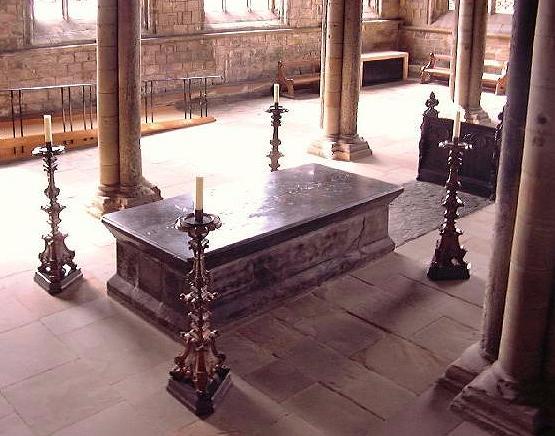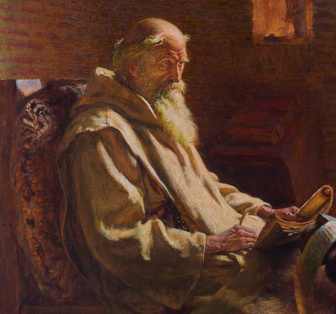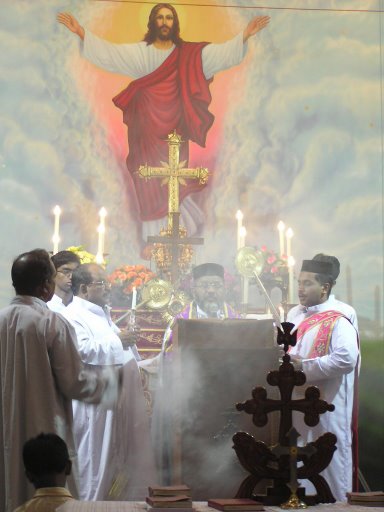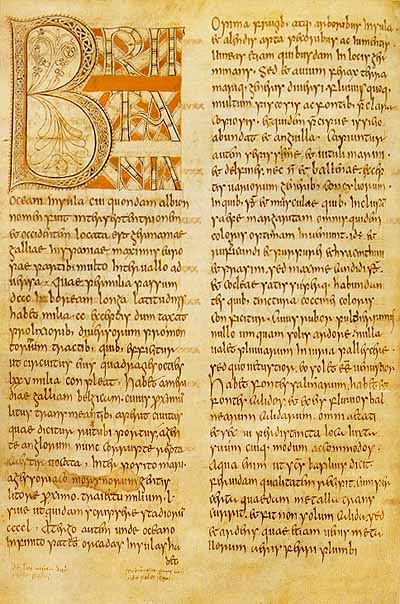|
Bede's Death Song
''Bede's Death Song'' is the editorial name given to a five-line Old English poem, supposedly the final words of the Venerable Bede. It is, by far, the Old English poem that survives in the largest number of manuscripts — 35 or 45 (mostly later medieval manuscripts copied on the Continent). It is found in both Northumbrian and West Saxon dialects. Attribution to Bede Bede died on Thursday, 26 May 735 (Ascension Day) on the floor of his cell, singing ''Glory be to the Father and to the Son and to the Holy Spirit'' and was buried at Jarrow. Cuthbert, a disciple of Bede's, wrote a letter to a Cuthwin (of whom nothing else is known), describing Bede's last days and his death. According to Cuthbert, Bede fell ill, "with frequent attacks of breathlessness but almost without pain", before Easter. On the Tuesday, two days before Bede died, his breathing became worse and his feet swelled. He continued to dictate to a scribe, however, and despite spending the night awake in prayer he ... [...More Info...] [...Related Items...] OR: [Wikipedia] [Google] [Baidu] |
Bede
Bede (; ; 672/326 May 735), also known as Saint Bede, Bede of Jarrow, the Venerable Bede, and Bede the Venerable (), was an English monk, author and scholar. He was one of the most known writers during the Early Middle Ages, and his most famous work, '' Ecclesiastical History of the English People'', gained him the title "The Father of English History". He served at the monastery of St Peter and its companion monastery of St Paul in the Kingdom of Northumbria of the Angles. Born on lands belonging to the twin monastery of Monkwearmouth–Jarrow in present-day Tyne and Wear, England, Bede was sent to Monkwearmouth at the age of seven and later joined Abbot Ceolfrith at Jarrow. Both of them survived a plague that struck in 686 and killed the majority of the population there. While Bede spent most of his life in the monastery, he travelled to several abbeys and monasteries across the British Isles, even visiting the archbishop of York and King Ceolwulf of Northumbria. ... [...More Info...] [...Related Items...] OR: [Wikipedia] [Google] [Baidu] |
Old English
Old English ( or , or ), or Anglo-Saxon, is the earliest recorded form of the English language, spoken in England and southern and eastern Scotland in the Early Middle Ages. It developed from the languages brought to Great Britain by Anglo-Saxon settlers in the mid-5th century, and the first Old English literature dates from the mid-7th century. After the Norman Conquest of 1066, English was replaced for several centuries by Anglo-Norman language, Anglo-Norman (a langues d'oïl, type of French) as the language of the upper classes. This is regarded as marking the end of the Old English era, since during the subsequent period the English language was heavily influenced by Anglo-Norman, developing into what is now known as Middle English in England and Early Scots in Scotland. Old English developed from a set of Anglo-Frisian or Ingvaeonic dialects originally spoken by Germanic tribes traditionally known as the Angles (tribe), Angles, Saxons and Jutes. As the Germanic settlers ... [...More Info...] [...Related Items...] OR: [Wikipedia] [Google] [Baidu] |
Alliterative Verse
In meter (poetry), prosody, alliterative verse is a form of poetry, verse that uses alliteration as the principal device to indicate the underlying Metre (poetry), metrical structure, as opposed to other devices such as rhyme. The most commonly studied traditions of alliterative verse are those found in the oldest literature of the Germanic languages, where scholars use the term 'alliterative poetry' rather broadly to indicate a tradition which not only shares alliteration as its primary ornament but also certain metrical characteristics. The Old English language, Old English Epic poetry, epic ''Beowulf'', as well as most other Old English poetry, the Old High German ''Muspilli'', the Old Saxon ''Heliand'', the Old Norse language, Old Norse ''Poetic Edda'', and many Middle English poems such as ''Piers Plowman'', ''Sir Gawain and the Green Knight'', Layamon's Brut and the ''Alliterative Morte Arthur'' all use alliterative verse. While alliteration is common in many poetic traditio ... [...More Info...] [...Related Items...] OR: [Wikipedia] [Google] [Baidu] |
Venerable Bede
Bede (; ; 672/326 May 735), also known as Saint Bede, Bede of Jarrow, the Venerable Bede, and Bede the Venerable (), was an English monk, author and scholar. He was one of the most known writers during the Early Middle Ages, and his most famous work, ''Ecclesiastical History of the English People'', gained him the title "The Father of History of England, English History". He served at the monastery of St Peter and its companion monastery of St Paul in the Kingdom of Northumbria of the Angles (tribe), Angles. Born on lands belonging to the twin monastery of Monkwearmouth–Jarrow Abbey, Monkwearmouth–Jarrow in present-day Tyne and Wear, England, Bede was sent to Monkwearmouth at the age of seven and later joined Abbot Ceolfrith at Jarrow. Both of them survived a plague that struck in 686 and killed the majority of the population there. While Bede spent most of his life in the monastery, he travelled to several abbeys and monasteries across the British Isles, even visiting t ... [...More Info...] [...Related Items...] OR: [Wikipedia] [Google] [Baidu] |
Ascension Day
The Feast of the Ascension of Jesus Christ (also called the Solemnity of the Ascension of the Lord, Ascension Day, Ascension Thursday, or sometimes Holy Thursday) commemorates the Christian belief of the bodily Ascension of Jesus into Heaven. It is one of the ecumenical (shared by multiple denominations) feasts of Christian churches, ranking with the feasts of the Passion and Pentecost. Following the account of that the risen Jesus appeared for 40 days prior to his Ascension, Ascension Day is traditionally celebrated on a Thursday, the fortieth day of Easter according to inclusive counting, although some Christian denominations have moved the observance to the following Sunday, sometimes called Ascension Sunday. The day of observance varies by ecclesiastical province in many Christian denominations, as with Lutherans and Catholics, for example. Ascensiontide refers to the ten-day period between the Feast of the Ascension and the Feast of Pentecost. The Sunday within that per ... [...More Info...] [...Related Items...] OR: [Wikipedia] [Google] [Baidu] |
Anglo-Saxon Poetic Records
The Anglo-Saxon Poetic Records (ASPR) is a six-volume edition intended at the time of its publication to encompass all known Old English poetry. Despite many subsequent editions of individual poems or collections, it has remained the standard reference work for scholarship in this field. History The edition was conceived by George Philip Krapp (1872–1934), who edited volumes 1, 2, and 5 while Professor of English at Columbia University, with the assistance of his student and colleague Elliott Van Kirk Dobbie. Krapp died partway through editing volume 3, and Dobbie completed this edition before going on to complete the series by editing volumes 6 (which came out in 1942) and 4 (which emerged in 1953).. According to Henry Wiggins, the long gap before the publication of Volume 4, which contains the poems ''Beowulf'' and ''Judith'', was partly due to Elliott's feeling that there was no urgency about completing the ''Beowulf'' volume, because there were so many competent editions. T ... [...More Info...] [...Related Items...] OR: [Wikipedia] [Google] [Baidu] |
Caesura
300px, An example of a caesura in modern western music notation A caesura (, . caesuras or caesurae; Latin for "cutting"), also written cæsura and cesura, is a metrical pause or break in a verse where one phrase ends and another phrase begins. It may be expressed by a comma (,), a tick (✓), or two lines, either slashed (//) or upright (, , ). In time value, this break may vary between the slightest perception of silence all the way up to a full pause. Poetry In classical Greek and Latin poetry a caesura is the juncture where one word ends and the following word begins within a foot . In contrast, a word juncture at the end of a foot is called a diaeresis. Some caesurae are expected and represent a point of articulation between two phrases or clauses. All other caesurae are only potentially places of articulation. The opposite of an obligatory caesura is a bridge where word juncture is not permitted. In modern European poetry, a caesura is defined as a natural phrase ... [...More Info...] [...Related Items...] OR: [Wikipedia] [Google] [Baidu] |
Northumbrian Dialect
Northumbrian dialect or Northumbrian English is any one of several traditional English dialects spoken in the historic counties of Northumberland and County Durham. The term ''Northumbrian'' can refer to the region of Northumbria but can also refer specifically to the county of Northumberland. This article focuses on the former definition and thus includes varieties from throughout the wider region. The traditional Northumbrian dialect is a moribund older form of the dialect spoken in the area. It is closely related to Scots and Cumbrian and shares with them a common origin in Old Northumbrian. The traditional dialect has spawned multiple modern varieties, and Northumbrian dialect can also be used to broadly include all of them: * Geordie, the most famous dialect spoken in the region, largely spoken in Tyneside, centred in Newcastle and Gateshead * Mackem, a dialect spoken in Wearside, centred on Sunderland * Smoggie, a dialect spoken in Teesside; an area at the souther ... [...More Info...] [...Related Items...] OR: [Wikipedia] [Google] [Baidu] |
Historia Ecclesiastica Gentis Anglorum
The ''Ecclesiastical History of the English People'' (), written by Bede in about AD 731, is a history of the Christian Churches in England, and of England generally; its main focus is on the growth of Christianity. It was composed in Latin, and is believed to have been completed in 731 when Bede was approximately 59 years old. It is considered one of the most important original references on Anglo-Saxon history, and according to some scholars has played a key role in the development of an English national identity. Overview The , or ''An Ecclesiastical History of the English People'', is Bede's best-known work, completed in about 731. The first of the five books begins with some geographical background and then sketches the history of England, beginning with Julius Caesar's invasion in 55 BC. A brief account of Christianity in Roman Britain, including the martyrdom of St Alban, is followed by the story of Augustine of Canterbury, Augustine's mission to England in 597, which brou ... [...More Info...] [...Related Items...] OR: [Wikipedia] [Google] [Baidu] |
Old English Poetry
Old English literature refers to poetry (alliterative verse) and prose written in Old English in early medieval England, from the 7th century to the decades after the Norman conquest of England, Norman Conquest of 1066, a period often termed Anglo-Saxon England. The 7th-century work ''Cædmon's Hymn'' is often considered as the oldest surviving poem in English, as it appears in an 8th-century copy of Bede's text, the ''Ecclesiastical History of the English People''. Poetry written in the mid 12th century represents some of the latest post-Norman examples of Old English. Adherence to the grammatical rules of Old English is largely inconsistent in 12th-century work, and by the 13th century the grammar and syntax of Old English had almost completely deteriorated, giving way to the much larger Middle English literature, Middle English corpus of literature. In descending order of quantity, Old English literature consists of: sermons and saints' lives; biblical translations; translat ... [...More Info...] [...Related Items...] OR: [Wikipedia] [Google] [Baidu] |






